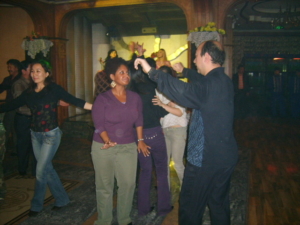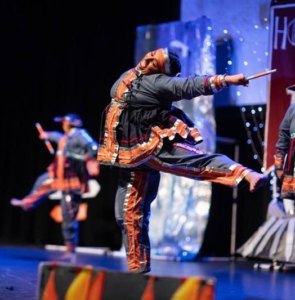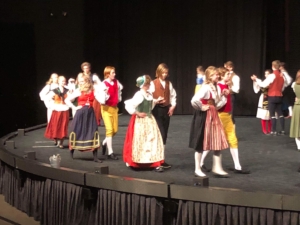DANCING ACROSS CULTURES
Dance is an art that has been around for millennia. 9,000-year-old Indian cave paintings serve as the earliest recorded indication of the art. More evidence of dance in ancient history appears in Egyptian tombs dated back to 3300 BC. Here at The International Center, we share our love for a diversity of cultures. Members of the office share their heritage of India, South Korea, Thailand, Sweden, France, Germany, and Mexico.
All around the globe, dance serves as a window to the past as well as showcase the modern joys and practices of today.

Kristie Johnson, VP of Development & External Affairs, studied at the Xinjiang Arts Institute.
China:
As a Fulbright scholar, our vice president, Kristie Johnson, set out to explore the significance of dance in Uyghur culture. The Uyghur people are a Turkic, Sunni Muslim ethnic group located in Xinjiang, China. In her findings, Kristie shared how Uyghurs use dance to embrace their culture, celebrate their identities, and create self-empowerment. Dance and music recount centuries of traditions and stories, performing to long narrative poems called the Twelve Mukam. Each was performed with different types of instruments and unique choreography at gatherings like weddings and harvest festivals.
“I first encountered Uyghurs as a Peace Corps volunteer in China. A few years later, I had an opportunity to research their traditional dances as a Fulbright scholar. I found through speaking with academics and performers that the Uyghurs would often use dance to celebrate but also as a means of preserving their cultural identity.” – Dr. Kristie S. Johnson, Vice President of Development & External Affairs

Neelam Patel, International Visitor Program Manager, performs with IU Hoosier Raas, a traditional Indian dance team.
India:
Bharatanatyam is one of the oldest classical dances in Indian heritage and originated in the Hindu temples in South India. Hindu stories and devotions are expressed through intricate footwork and gestures. The style is composed of three aspects: nritta, nritya, and natya. Nritta is dance in its purest form, just the movements. Nritya incorporates gestures and facial expressions into the movement. Finally, natya adds flair, bringing in performance, dialogue, and story.
“Dance is cultural- it’s community. It brings back positive memories because it means being together.” – Neelam Patel

Maja Ahlberg, International Business Development, Research Analysis and Consulting Intern, performs the with her school class.
Sweden:
Maja, one of our lovely interns here at The International Center, shared her experiences with cultural dance back home in Sweden. A well-known form of Swedish folk dance is polka. It originated in the 16th century and is typically a dance for couples. The pair pivot around each other to lively music, usually in a ¾ time signature.
“We all learned polka in PE at school. I felt really connected to my culture and my ancestors.” -Maja Ahlberg
United States:
Native American tribes use dance almost as a language itself. Like in other cultures, it serves as a means to unify communities. Each of the 574 tribes currently recognized in the US have dances unique to them as well as others that they share. Round dances often introduced guests or other tribes. Native to Indiana, the Shawnee tribe has a greeting dance. Other dances celebrate harvests, seasonal changes, celebrations, and major life events. Today, various dances are shared at powwows across the country.
All around the world, dance is expressive, unifying, and feeds the soul, and it changes based on the type of occasion. Do you have any dance traditions? What do they mean to you?
By: Amelie Zirnheld | Marketing & Communications Intern

